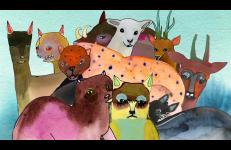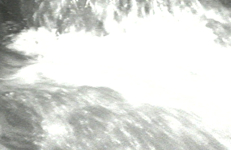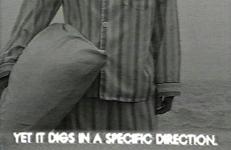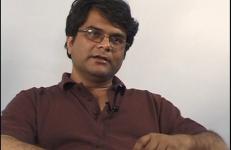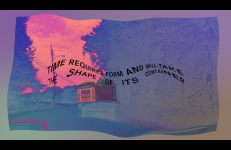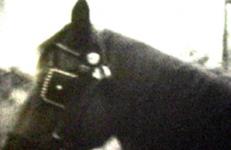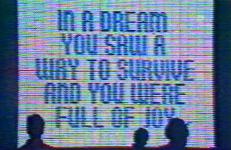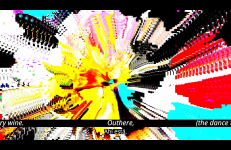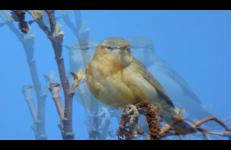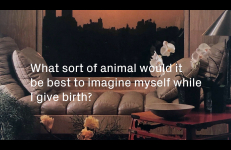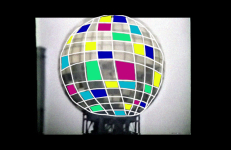A "young woman who finds herself surrounded by the relics of Western culture" is the subject of Richard Foreman's formal tableaux. The narration centers on a young woman's struggle to find a relation between her body and her self as mediated by language. The text is a poetry of formal relations that carries personal and historical implications, including the desires of the woman paradoxically voiced by a male narrator. The title suggests the vivid virtuality of dreaming; scenes repeatedly refer to both reading and sleeping.
Language
Partially Buried Continued is a meditation on ways in which one’s associations to history, location, and genealogy become tangled in a subjective web which makes it complicated to separate history from fiction.
This compilation is produced with "myself" as the sole object, as well as the material of the performance (except two videos with Akiko iimura). The videos are not just documents of the performances, but works of video-art made specifically for utilizing the video system, including the camera and monitor, as part of the performances. The collection also questions the identity of oneself in video, having tense relationships between words and images, and asks who is "I" and what "I" means.
DVD includes:
Self Identity, 1972, 1:00 excerpted
Using footage from a trip to the Orient, images of objects, products, the city and nature, Rankin investigates society's reverance for the "exotic" and the "pure" as manifested in tourism, Communism, Coca-Cola, Las Vegas, the Civil War, Hollywood, and photography. Examining the common idealisation of things distant in time or space, The Pure didactically reflects upon our societal penchant for categorization that begins with childhood games and is reflected in the way our culture organizes itself and the world around it.
A portrait of the artist as a not-so-young man. The filmmaker attempts to enter the digital age by making a new video version of one of his old films.
"The award of the Short Film Festival goes to a video in which the reflection of artistic work becomes a form itself. John Smith manages to give us a self-ironic humorous experiment about art and time."
—Prize of the International Short Film Festival, Oberhausen 2000
This title is also available on John Smith: Program 2.
"A major influence for generating ideas for me was not what I could contrive on my desktop, but being open and receptive to “accident”. For instance, one evening in 1972 while typing a syllabus for a class on my old Smith Corona typewriter, I happened to see on the TV a documentary by Leni Riefenstahl. German troops were marching, and I found that I could duplicate the “ta ta tum, ta ta tum, ta ta tum tum tum” of the drumbeat by typing “mar mar march mar mar march.“ Had not the broadcast of this film taken place while I was typing, I would never have thought of this concept.
Steve Reinke has long been lauded for his irreverent, philosophical, and often acerbic works, which typically adopt the form of personal essays to wryly bend and reread wide-ranging topics, from pop culture, to sex, to theories of visual perception and beyond. Reinke’s video, included in the 2014 Biennial, Rib Gets in the Way, is narrated in the first person by Reinke, and addresses mortality, the body, the archive, and the embodiment of a life’s work.
The seemingly groundless debate as to whether a river is "riley" or "roily" can be interpreted as an example of language's descriptive failure. A shouting match over how to describe the river has no effect; the face of nature continues unchanged. Riley, Roily, River graphically illustrates the gap of meaning that exists between the natural, empirical world and the language we use to describe it.
Taking its title from a poem by Paul Celan (translated as “sleeping den”), this montage is the result of a script that reconfigures over two hundred lines of English subtitles, lifted from films ranging from Battleship Potemkin and Persona, to The Bitter Tears of Petra Von Kant. The disconcerting soliloquy on love and insomnolence is deliberately attempted in the original French, German, Russian, Italian, and Swedish.
Taking its title from a sound design maxim and using it as a conceit to grasp the desire for connection, See A Dog, Hear A Dog probes the limits and possibilities of communication. In this liminal cinematic space, the fear of conscious machines is matched with a desire to connect with nonhuman entities. Algorithms collaborate and improvise. Dogs obey/disobey human commands, displaying their own artistry and agency in the process. Technology, from domesticated animals to algorithmic music to chat rooms, reflects human desires but has its own inventiveness.
From A to Z in this mock cooking-show demonstration Rosler 'shows and tells' the ingredients of the housewife's day. She offers an inventory of tools that names and mimics the ordinary with movements more samurai than suburban. Rosler's slashing gesture as she forms a letter of the alphabet in the air with a knife and fork is a rebel gesture, punching through the 'system of harnessed subjectivity' from the inside out.
"I was concerned with something like the notion of 'language speaking the subject', and with the transformation of the woman herself into a sign in a system of signs that represent a system of food production, a system of harnessed subjectivity."
— Martha Rosler
In this interview, Indian artist Shuddhabrata Sengupta (b. 1968) discusses his role in the initiation of the Raqs Media Collective, a Delhi-based artist collective, active since the 1990s. At the time of this interview, Raqs had been creating documentaries, art installations, and educational programs for eighteen years. Sengupta likens the driving force of Raqs to that of a game of catch, a process generated by a back-and-forth dialogue mobilized through writing and in-person meetings. As children of the late sixties, Sengupta explains how and why the members of Raqs, (himself, Jeebesh Bagchi and Monica Narula) share an interest in investigating mass communication, technologies of visibility, and the significance of memory and travel. It is also for this reason, Sengjupta explains, that the Collective’s work is committed to fostering rigorous research in addition to art-making endeavors.
Sentences is a beguiling, hypnotic meditation on the poetics of space.
Paul and Veena, two disembodied computer voices, wonder what things mean and what means things. We travel with them to various imagined places in this visually spare video, meditating on the in-between places and negative space where meaning hides out. Their discourse is interrupted by non-verbal utterances and coughs, out of which Magenheimer’s voice sings Everybody’s Talkin’ by Fred Neil, then disappears again, sinking back into the digital sonic depths.
A young communist girl named Sharambaba resists her suitor in a carriage. She speaks of what he calls her "fantasy world". All of the dialogue is played backwards with accommodating subtitles.
This title is also available on Jim Finn Videoworks: Volume 1.
On the eve of the 1984 Presidential election, Jenny Holzer used a truck equipped with a sound system and an 18-foot Diamond Vision electronic board to display images, statements, and man-on-the-street interviews. This tape presents a tightly edited version of the art, texts, and interviews that occurred throughout the day.
"Love at first sight, one night, down at Silverror’s Saloon!" Mickey R Mahoney and jonCates direct Silverror’s Saloon, the next film in the 鬼鎮 (Ghosttown) Glitch Western series of films and games. Written by Emily Mercedes Rich and jonCates, this experimental film queers, glitches, and questions the Western film genre. We encounter characters caught in a glitched cinematic magic moment: a love scene. First dance with a stranger. Home and far from home.
"Love at first sight, one night, down at Silverror’s Saloon!" Mickey R Mahoney and jonCates direct Silverror’s Saloon, the next film in the 鬼鎮 (Ghosttown) Glitch Western series of films and games. Written by Emily Mercedes Rich and jonCates, this experimental film queers, glitches, and questions the Western film genre. We encounter characters caught in a glitched cinematic magic moment: a love scene. First dance with a stranger. Home and far from home.
We hear a female voice with a subtle Jamaican accent speak about her life. Sometimes we see an image; a bird, two birds, fire, someone digging a giant hole, cake, a red anvil with an effervescent essence, and sometimes we are left in the dark with only our imaginations in this sound-driven video. Along the way we consider the nature of human existence, the transfiguring power of sex, and the physicality of words.
John Smith, throughout his 40-year career, has approached the moving image from film, video and installations, generating a tremendous body of work that’s as diverse in its topics as it is in its methods. Weaving between early structuralist film and more personal, diaristic, documentary approaches to the places in which he lived, most notably London, his output is both broad and varied.
Employing the 'case studies' of Helen Keller, Genie the 'wild child' and Angel at My Table author Janet Frame, Goss's extraordinary video contemplates the struggle to be heard, to break free from the prison of the incommunicable self. '[A] tour of the house and grounds of language,' constructed with beguiling visual spaces and surfaces, startling edits, and insinuatingly layered sound design. —New York Video Festival (2000)
Directed by artist and filmmaker Tiffany Sia, The Sojourn imagines a restless landscape film in Taiwan. Visiting scenic locations shot by King Hu, the short experiments with the road movie genre and its intersection with the martial arts epic. Sia meets actor Shih Chun, who played the protagonist in Hu’s Dragon Inn, Touch of Zen and other wuxia films, as he guides the quest to re-encounter the iconic landscapes where Dragon Inn was shot. He counsels on the perfect conditions of mist and weather.
Prompted by Apple’s Siri to ask questions, Magenheimer takes the AI invitation seriously and invents a long list of queries. We see them appear one by one over scanned images from Architectural Digest magazine’s idealized interiors of 1981, the year Magenheimer was born and the year Ronald Reagan became president.
A Song from the Cultural Revolution is a stuttering music video composed of appropriated footage of Bill Gates’s testimony before the U.S. Senate. Gates’s hand gestures have been re-edited, frame-by-frame, into ASCII (American Standard Code for Information Interchange) signs for a text from “Methods of Thinking, Methods of Work,” Quotations from Chairman Mao Tse-tung (New York: Bantam, 1967).
This title is also available on Les LeVeque Videoworks: Volume 1.
The Source is a Hole poses a web of loose connections and liminal associations to sculpt a treatise on transexual mourning. As a series of love letters, stories recount the authors own inception at the 1982 world’s fair, his attempt to remove a lodged tampon, his cravings for bottomless eros, and a barrage of tangential encounters, spanning the everyday, to performance reenactment, to science fiction cinema analysis and drag.










